Study in Brief
- Business investment in Canada has been so weak since 2015 that capital per worker is falling.
- A longstanding gap between investment per available worker in Canada compared to the United States and other OECD countries narrowed from the late 1990s through the early 2010s, but has since widened to a chasm. In 2024, Canadian workers will likely receive only 66 cents of new capital for every dollar received by their counterparts in the OECD as a whole, and 55 cents for every dollar received by their US counterparts.
- Labour productivity and investment go together. Productivity growth creates opportunities and competitive threats that spur businesses to invest. Investment increases productivity by equipping workers with better tools. Investment per worker that is lower in Canada than abroad tells us that businesses see less opportunity in Canada and prefigures weaker earning growth and living standards than elsewhere.
- We need pro-growth reforms to stimulate business investment and prevent Canadian workers from being relegated to low value-added activities compared to workers in other countries.
The authors wish to thank Don Drummond, John Lester, Richard McIntosh, Nick Pantaleo, Jeffrey Trossman and anonymous reviewers for comments on an earlier draft. The authors retain responsibility for any errors and the views expressed.
Introduction and Overview
Slow growth in Canadian productivity and living standards has become a top-of-mind concern for Canadian economy watchers and, increasingly, for Canadians generally. An array of recent publications has highlighted declining real gross domestic product (GDP) per person in Canada and its ominous implications for Canadians’ standard of living (Porter 2024, Marion and Ducharme 2024, Ercolao 2023). A recent Statistics Canada report documented a huge decline from Canada’s previous trend rate of economic growth (McCormack and Wang 2024), and the Senior Deputy Governor of the Bank of Canada made headlines in March when she described Canada’s dismal productivity performance as an “emergency” that meant it was “time to break the glass” (Rogers 2024).
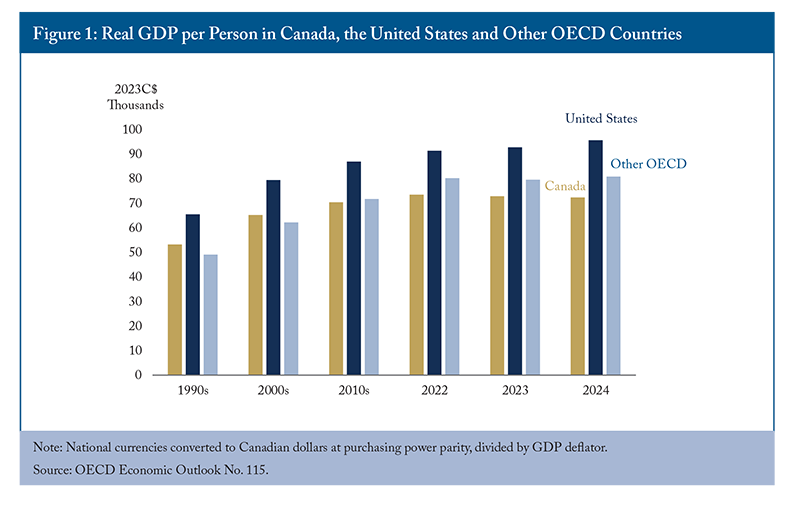
Second-quarter 2024 data showed that real GDP per Canadian had fallen for five straight quarters. As if that were not bad enough, the gap between GDP per person in the United States and Canada is widening, and GDP per capita in other Organisation for Economic Co-operation and Development (OECD) countries has significantly outpaced Canada’s (Figure 1), implying that Canada is becoming a less attractive place for talented people to live and work.
Weak business investment is at the core. High or low levels of capital and productivity tend to go together because rising productivity spurs investment, and investment spurs higher productivity.
Rising productivity can result from improvements in human capital that raise potential output per worker or from technological progress that raises potential output per unit of all kinds of inputs – often called “multifactor productivity.” Either source of productivity gains – improvements in human capital or technological progress – can create opportunities and competitive threats that promote business investment. Higher business investment spurs productivity because it gives workers newer and better tools, embodies new technologies and gives managers and workers new opportunities to “learn by doing.”1
The links between investment and productivity make recent figures on Canada’s capital stock and new investment worrying. Canada’s capital stock has grown so little since 2015 that capital per member of Canada’s labour force has been falling. Clearly, the recent extraordinary immigration-driven growth in Canada’s labour force is not prompting businesses to tool up to deploy the newly available brains and hands. The spectacle of falling capital per worker forces attention to the fact that capital and labour are not only complementary factors of production – they are also substitutes.
Different products and modes of production use labour and capital more or less intensively, and as countries trade with each other, those with higher per-worker capital levels are likelier to specialize in capital-intensive goods and services, while countries with lower levels are likelier to specialize in labour-intensive goods and services. Since living standards are higher in capital-intensive countries, we have to worry about the possibility that low business investment and fast workforce growth are leading Canada down a labour-intensive path.
The US and other OECD countries are not following that path – they are investing at higher rates. Business investment per available Canadian worker was approaching comparable US and OECD measures from the early 2000s to the middle of the last decade, but the convergence stopped around 2015. Canada’s relative performance then plummeted during the COVID pandemic and has lagged badly since.
Canada’s workers, whether born in Canada or abroad, need better tools to thrive and compete. Governments must change policies that threaten to take Canada’s economy down a more labour-intensive, lower-wage path.
Many types of capital enhance productivity and living standards. Our focus in this Commentary is on “built capital” in the business sector. Human capital and natural capital such as land and water matter, but we lack good measures of either and cannot compare them internationally. Capital created and owned by governments also matters, but the services it yields are harder to relate to production and income.
Measures of built capital are relatively robust and easier to compare internationally. Non-residential buildings include items such as offices, warehouses and industrial facilities, as well as engineering structures such as transportation infrastructure. Machinery and equipment (M&E) includes items such as motor vehicles, tools and electronic equipment. Intellectual property (IP) products have three major sub-components (see Box 1). These types of built capital complement human and natural capital, as well as government infrastructure, in producing goods and services, generating incomes and helping workers compete internationally.
Notwithstanding the importance of other inputs and other influences such as organization of firms that fall into the “multifactor productivity” category, countries with high capital stocks clearly tend to enjoy high output.
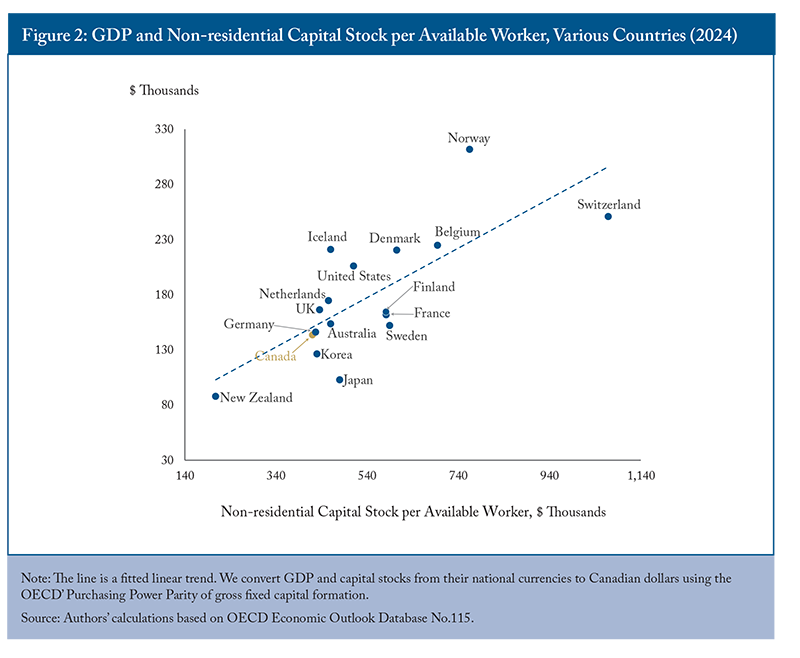
Productivity growth and investment interact. Anticipated higher productivity creates opportunities for growth and profit for businesses, as well as threats from innovative competitors and losses. Those opportunities and threats incent investment, which increases the quantity and quality of the capital stock. A larger, newer capital stock raises productivity and workers’ incomes. The correlation between capital stock per member of the labour force2 – for which we use the term “available worker”– and output per available worker across countries is clear (Figure 2).3
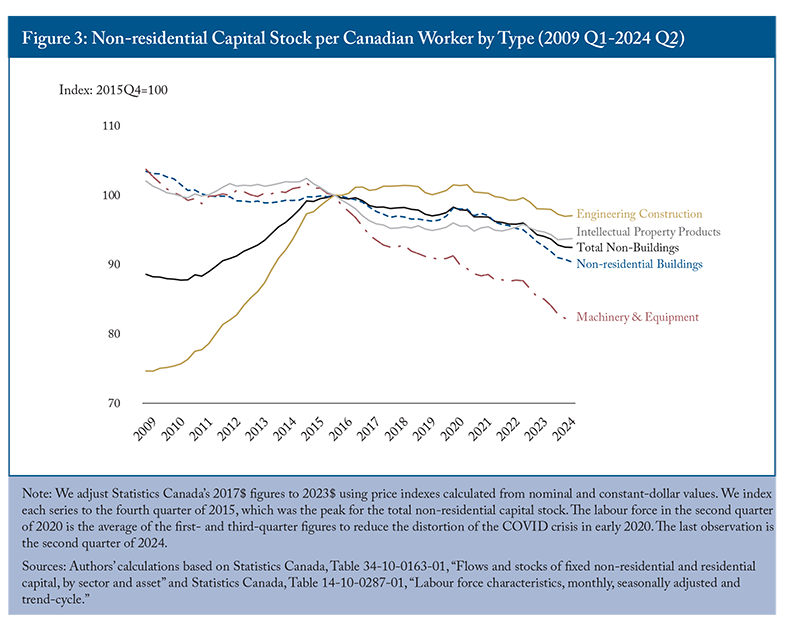
The fact that capital formation is both a result of productivity growth and a driver of it makes recent trends in Canada’s capital stock troubling. Figure 3 shows real stocks of each type of capital per member of Canada’s labour force.4
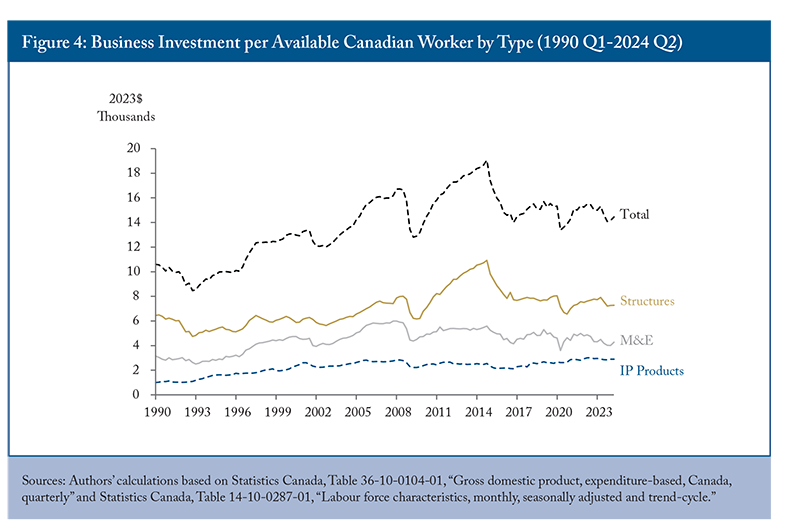
Total non-residential capital per available worker peaked in the last quarter of 2015. By the second quarter of 2024, all types of capital were below their late 2015 per-worker levels. Engineering construction per available worker was down a comparatively small 4 percent. IP products were 9 percent below their peak. Non-residential buildings were down 13 percent. M&E was down a dramatic 21 percent. The dismal summary: the latest figures show the average member of Canada’s labour force had 8 percent less capital to work with than she or he had in 2015.
Because we do not have comparable capital-stock numbers for many other countries, we turn to the related flow measure – gross business investment – to set up an international comparison over time. Figure 4 shows the Canadian numbers for the three types of business investment – non-residential structures (buildings and engineering), M&E and IP products – per member of the workforce since 1990.
Absent changes in estimated depreciation and write-offs, changes in gross investment should reconcile with changes in net capital stock. From 1990 to 2014, notwithstanding setbacks during the slump of the early 1990s and the financial crisis and recession of 2008-2009, the trend in investment per worker was up. During the second half of the 2010s, investment in structures and M&E per member of the workforce declined, and investment in IP products flatlined. The COVID pandemic and the associated economic shutdowns and uncertainty hurt all kinds of investment. Since then, performance in all three categories has been lacklustre. Adjusted per-available-worker investment in the second quarter of 2024 was only about $14,000 in 2023 dollars – down almost one quarter from its 2014 peak of $18,600.
Canada’s Investment Performance in International Perspective
COVID affected many countries. Other factors that might affect traditional capital formation, such as the growing importance of intangible assets and the declining materials intensity of economic activity, generally, also affect other countries and do not imply lower real incomes or losses of competitiveness. We can check Canada’s experience against that of the US and other OECD countries with comparable data (the same countries that appear in Figure 2). Is Canada’s apparent path toward lower capital intensity part of a broader and possibly benign global pattern, or is Canada on a unique path that raises unique concerns?
Canada and the US collect similar capital investment data and Statistics Canada takes particular care to compare Canadian to US prices. We can measure investment per available worker in the two countries with some confidence that we are getting meaningful numbers.
We convert the different types of capital investment into Canadian dollars using Statistics Canada’s measures of relative capital-equipment price levels to adjust for purchasing power differences.5 Our adjustment provides a better idea of bang per buck spent on structures, M&E or IP products on either side of the border. The results of these calculations appear in Figure 5, panels A through D.
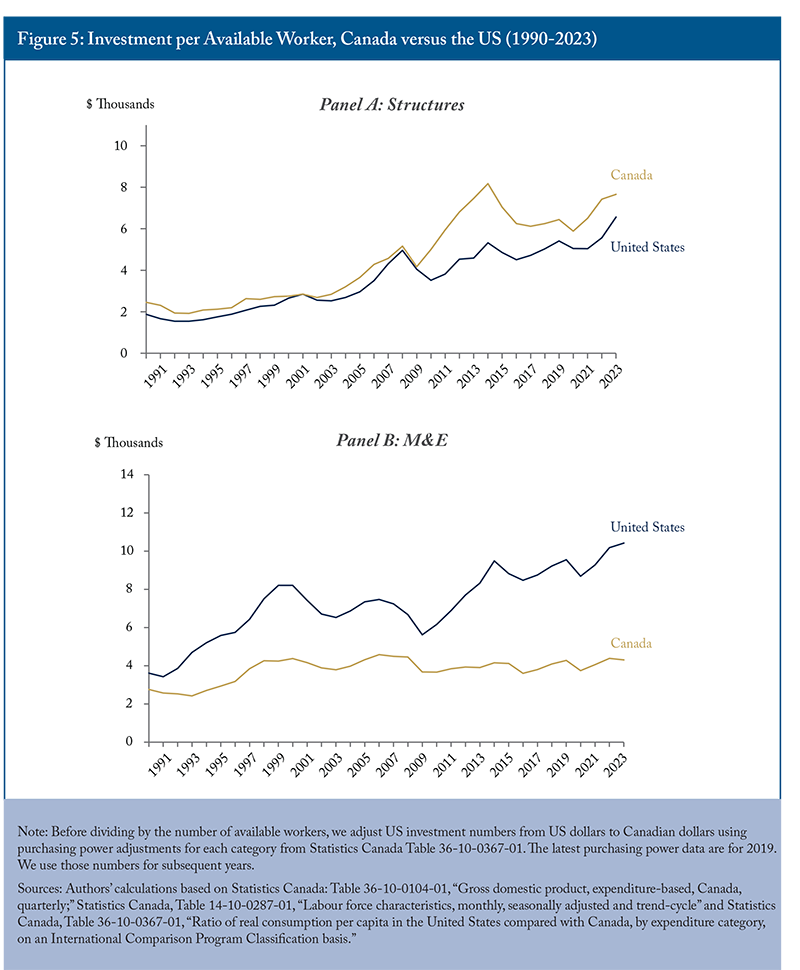
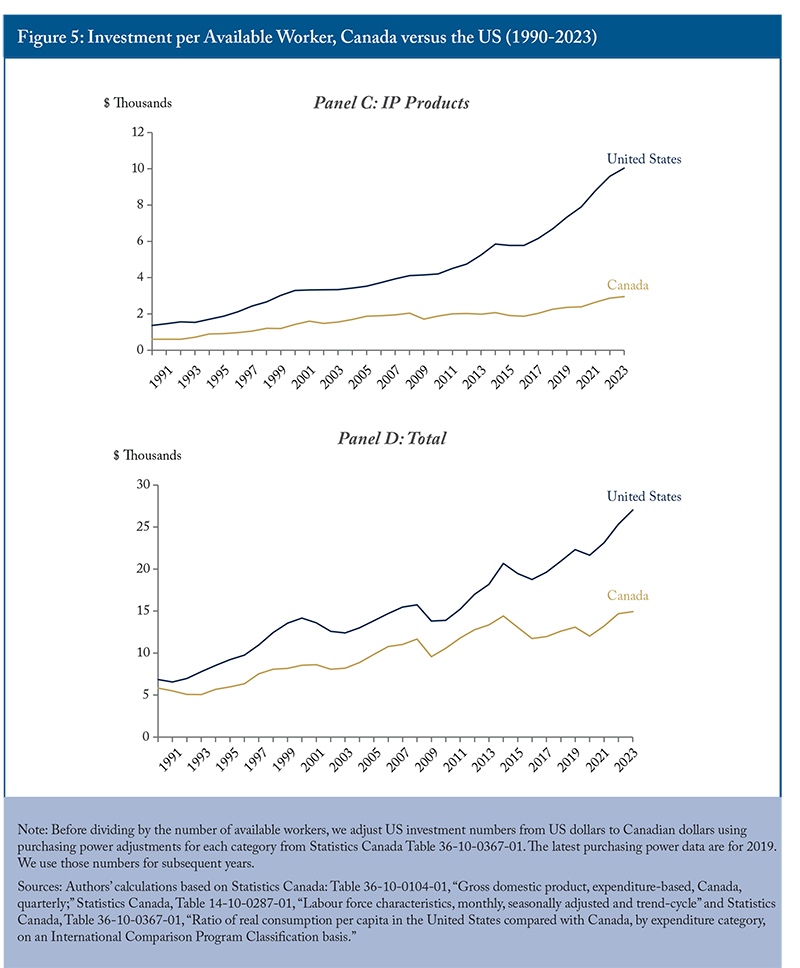
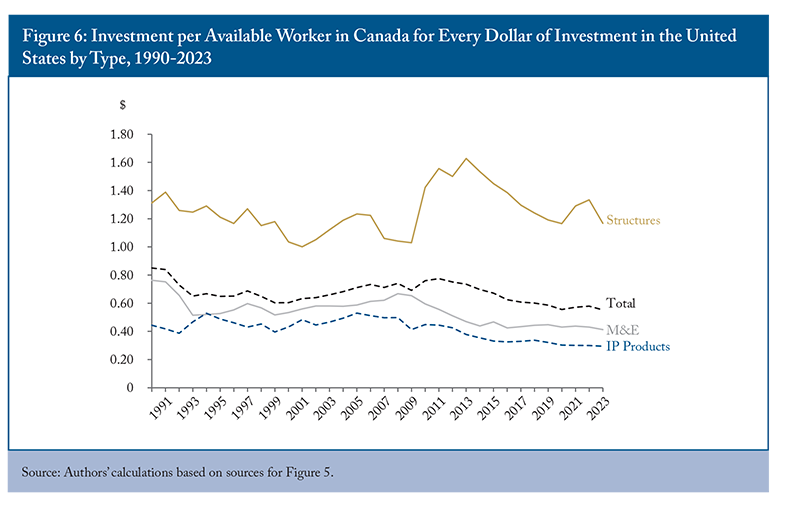
Canada has an edge in investment in structures (panel A), a type of capital on which Canadian businesses, with their relatively greater focus on natural resources, tend to invest in more. This edge over the US shrank after 2014, with lower oil prices and a Canadian policy environment more hostile to the development of natural resources. The Canada-US per worker gap shrank from almost $3,000 in 2014 to just over $1,000 in 2023.
The comparison in M&E investment (panel B) is markedly different. The US has a longstanding edge in that type of investment, which has recently become more pronounced. US M&E investment per available worker has lately been 2.5 times higher than in Canada – about $10,000 annually in the US compared to $4,000 in Canada. Given the potentially outsize importance of M&E investment for productivity growth (Sala-i-Martin 2001, Rao et al. 2003, Stewart and Atkinson 2013), this gap bodes poorly for the competitiveness of Canadian workers against their US counterparts and for the attractiveness of Canada as a place to live and work.
The IP products gap (panel C) is worse yet. In 2008, Canadian business spending on these products was about $2,000 per available worker, and the US figure was about $4,000. In 2023, the Canadian figure had crept up to about $3,000, while the US figure soared to more than $10,000. Some of the current gap reflects slumping exploration expenditures by Canada’s struggling resource sector. More generally, this gap might reflect greater use by Canadian businesses of services produced by IP products owned abroad or lesser use of IP products created and owned in Canada due to lack of success in commercializing them, with ambiguous implications for productivity. Reliance on services from foreign-owned IP products might be simply a smart business decision, or it might reflect Canada’s lack of competitiveness in commercializing the intellectual property Canadian firms own, leading to lower accumulation of IP products.
The gap in all three types of investment together (panel D) has run in the US favour since the 1990s. It narrowed in the 2000s but widened markedly after the mid-2010s and widened further after the pandemic, reaching $12,000 per potential worker in 2023. That is a chasm. Differences in investment per worker on that scale could represent a significant shortening of the replacement and upgrade cycle for equipment such as trucks, excavators or machine tools, workplace equipment, and the potential replacement of entire information and communications technology systems, all of which would offer the workers enjoying the larger investment a noticeable improvement in the reward they get for their work
Asking how many cents of new investment per available Canadian worker occurs for every dollar of new investment per available US worker yields a comparative measure. In Figure 6, we show our measure of investment in Canada per dollar of its US equivalent in total and in each investment category.
Canada’s relatively robust rate of structure investment stands out in Figure 6. The surge to the 2013 comparative peak – when each available Canadian worker was getting more than $1.60 for every dollar of new structures enjoyed by her or his US counterpart – is striking. So is the subsequent decline to $1.20 in 2019 and 2020. After recovering from 2020 to 2022, Canada lost some ground in 2023, when the average member of the Canadian workforce received $1.17 of new capital for every dollar received by the average member of the US workforce.
As the comparison in Figure 5 suggested, the contrast is worse for M&E. After improving from just 50 cents around the turn of the century to nearly 60 cents around the time of the 2008–2009 financial crisis and slump, M&E investment for every available Canadian worker per dollar enjoyed by a US worker dropped to a dismal 41 cents in 2023.
The situation with IP products is worse yet. A declining trend since the mid-2000s has led to the point where the average member of the Canadian workforce in 2023 enjoyed only 30 cents of new investment in IP products for every dollar enjoyed by his or her US counterpart. Breaking this down by category reveals an even grimmer reality (Box 1).
Add the three types of capital together, and we see that new investment per available Canadian worker in 2023, adjusted for purchasing power, was only 55 cents for every investment dollar per US worker. That is lower than at any point since the beginning of the 1990s. As an indicator of business judgments about the attractiveness of capital investment in Canada versus the US, this record raises serious competitive concerns. The implications for future incomes on the northern side of the border are ominous.
Widening the international comparison to other OECD countries offers more perspective on Canada’s situation.6 This broader and more forward-looking view comes with caveats. Not all OECD countries break down business investment by type the same way Canada and the United States do, and some measures, notably IP products, differ across countries. Therefore, we use aggregate investment with less confidence that we are comparing like with like. We also do not have current measures of relative prices for different types of investment. We resort to a less precise bang-per-buck adjustment: purchasing-power-adjusted exchange rates benchmarked to relative prices of capital investment goods and services in 2017.
For consistency, we use the same OECD measures for the US as well, which means that the per-available-worker numbers in Canadian dollars are not identical to those in our Canada-US comparison. But the big picture – notably, the story of Canadian underperformance – is consistent (Figure 7).7
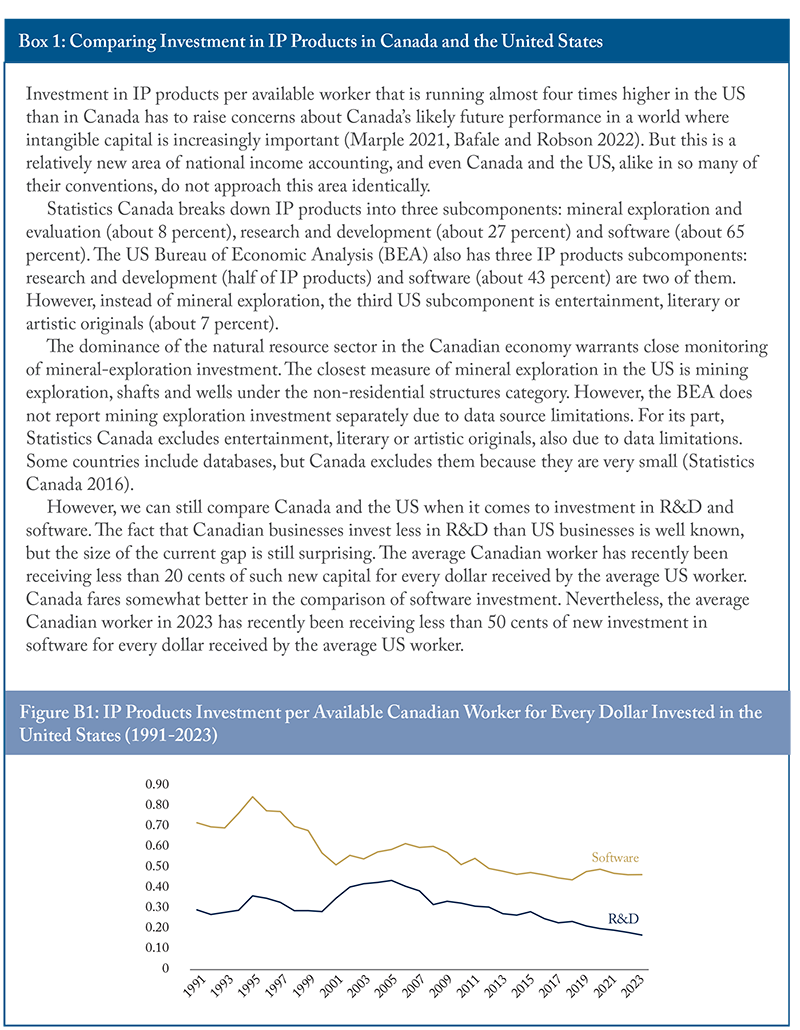
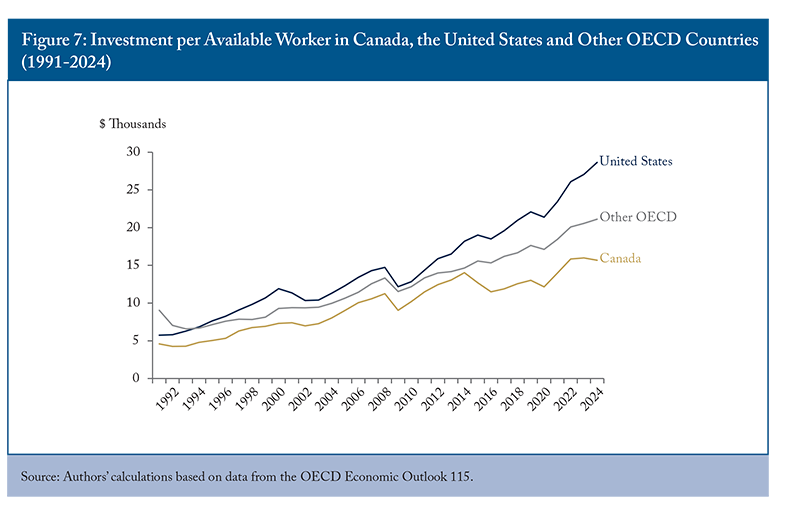
Investment per available worker in the other OECD countries with comparable data has typically been less robust than in the United States but more robust than in Canada. This tendency was less pronounced in the early 2010s, when Canada’s resources sector was booming, and many other advanced economies were suffering the lingering effects of the 2008-2009 crisis and slump. At that point, the gap between investment per Canadian labour force member and those in other OECD countries (excluding the US) narrowed, and the two measures were almost equal in 2014.
Since then, slumping investment in Canada and steady growth in the other OECD countries has made the gap wider than at any time since the early 1990s. The OECD’s projections for 2024 yield a figure of $21,100 of new capital per available worker this year for the other OECD countries compared to $15,700 for Canada. In other words, the OECD’s projections for countries other than Canada and the United States indicate that gross new capital per available worker in Canada will be about one-quarter less than in those countries this year.
In Figure 8, we highlight Canada’s relative performance by showing Canadian investment per worker for each dollar invested elsewhere. The figure shows how much new capital each available worker in Canada enjoyed per dollar of new capital per available worker in the US, the OECD as a whole and in the other OECD countries since 1991, along with the figures calculated from the OECD’s 2024 projections.
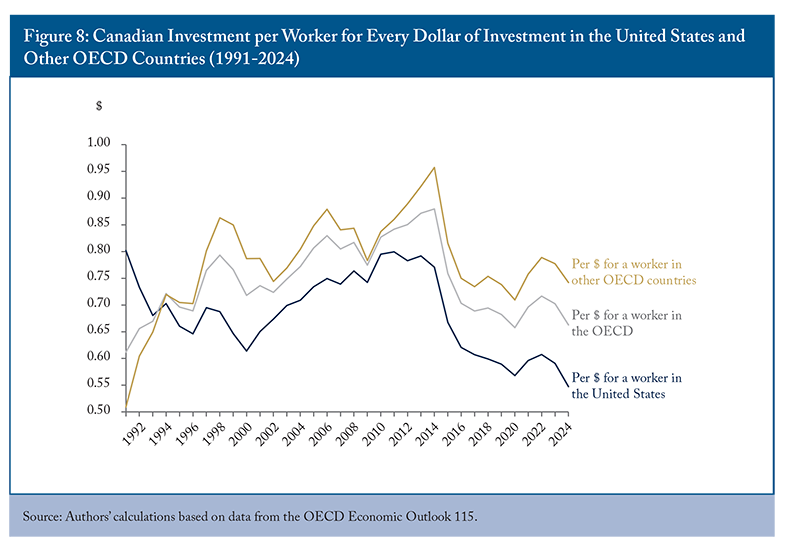
For every dollar of investment enjoyed by the average member of the labour force in the OECD as a whole, the Canadian counterpart enjoyed about 75 cents in the early 2000s. Compared to other OECD countries, excluding the US, Canadian workers received more than 80 cents. By 2014, the average Canadian labour force member was enjoying some 90 cents of new investment per dollar invested per worker in the OECD as a whole and 96 cents in the other OECD countries. In 2024, however, Canadian workers will likely enjoy only about 66 cents of new capital for every dollar enjoyed by their OECD counterparts. The figure compared to workers in the other OECD countries is 74 cents. The figure compared to US workers is a dismal 55 cents.
Canada’s Productivity Performance in International Perspective
Higher investment is not a goal in its own right. Subsidies and regulations that spur investment in uneconomic assets could raise capital spending but lower productivity and future incomes.8 Our concern about these numbers is their implication that Canadian businesses either do not see opportunities and competitive threats that would prompt them to undertake productivity-improving capital projects, or that when they see such opportunities and threats they respond slowly or incompletely. To that extent, these numbers presage trouble for Canadian workers. As one would expect from the relationship between capital stock and output per available worker in Figure 2, and as previous research such as that by Rao et al. (2003) has noted, countries with higher capital intensity tend to have higher productivity and higher wages, and countries with lower capital intensity tend to have lower productivity and lower wages. Unless human capital per worker is rising and/or multifactor productivity is rising fast enough to offset it, falling built-capital per worker means less output for every hour those workers work.
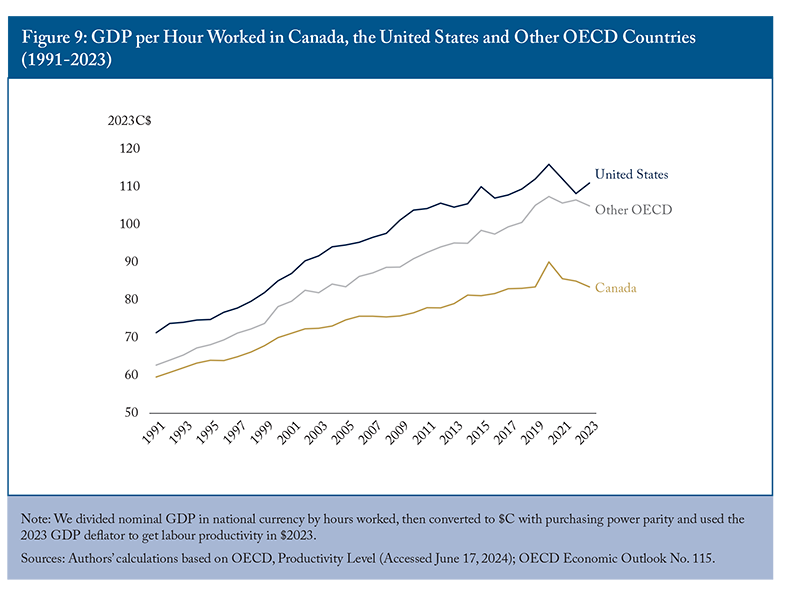
In the 1990s, US workers produced $12 more per hour than their Canadian counterparts, and the gap has widened since. In the 2000s and 2010s, Canada generated respectively $74 and $81 per hour worked, compared with $93 and $107 for the US. In 2023, Canada generated just $83 per hour worked compared to $111 in the US (Figure 9).
The gap between output per hour in other OECD countries and in Canada was narrower in the early 1990s but has since widened. Other OECD countries have increased their productivity at a rate similar to the United States, while Canada has lagged. In the 1990s, Canada generated $64 per hour worked compared to $68 per hour of work in other OECD countries – a gap of about 6 percent. In 2023, Canada generated $83 per hour worked compared to $105 in other OECD countries – a gap of 20 percent.
As we did with respect to investment per available worker, we can highlight Canada’s relative performance by showing Canadian output per hour worked for each dollar of output generated per hour worked elsewhere (Figure 10). In the 1990s, Canadian workers produced 84 cents for every dollar of output generated by US workers. By the 2010s, the ratio was around 75 cents, which is where it stood in 2023. In the 1990s, Canada generated 93 cents per hour worked for every dollar in other OECD countries. By the 2010s, the ratio was 83 cents, and by 2023, it had fallen to 80 cents.
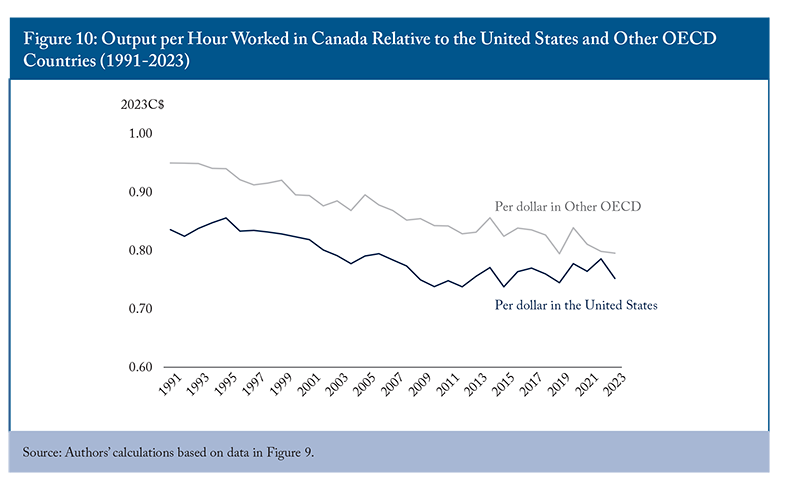
Diagnoses and Possible Responses
What lies behind these ominous numbers and how might Canadian governments respond? Causation flows both ways between productivity and investment, but an investigation can usefully start by asking why Canadian businesses may not respond to opportunities and threats as much as they did previously or compared to businesses in other countries. We do that in the next subsection, and then ask why Canadian businesses might see fewer opportunities and threats than before and fewer than those in other developed countries.9
Why Might Canadian Businesses Respond Less to Opportunities and Threats?
Do Canadian businesses have some structural predisposition against innovation, entrepreneurship, investment and productivity growth? Porter (2023) provides a list of commonly blamed factors, including low population density, a cold climate, reliance on resource-sector revenues, weak private-sector research and development efforts, and interprovincial barriers. As Porter points out, however, other countries with similar characteristics are outperforming Canada. Moreover, factors that have remained unchanged for decades cannot fully explain Canada’s poor performance since the mid-2010s, unless their impact has intensified. Why might Canadian businesses have been less responsive to opportunities and threats since 2014?
One influence that might have grown stronger is Canada’s bias toward residential construction.10 The federal government backs mortgage lending, likely leading lenders to favor residential over non-residential investments (Omran and Kronick 2019). Although mortgage lending has exceeded business lending in Canada since the mid-1980s, a tougher environment for non-residential investment and higher immigration since the mid-2010s may have made residential investment even more attractive. Although imports can augment the resources available for capital investment in a given year, domestic output over time limits the total amounts available for consumption and investment of all kinds. As a result, a growing share of residential investment in GDP could limit the responsiveness of non-residential investment to opportunities and threats.
A clearly negative influence is the hostile regulatory environment for Canada’s fossil fuel industry since 2015.11 While global investment in oil and natural gas dropped when prices weakened in 2014, the subsequent recovery spurred a much stronger response in the United States than in Canada. In 2014, oil and gas industry investment per worker in Canada, adjusted for purchasing power, was 83 cents for every dollar invested per US worker. By 2021, it had fallen to 52 cents, indicating a muted response to strong demand and high prices on the Canadian side of the border. A hint about the importance of the regulatory environment in the Canadian data is the relatively robust performance of investment in conventional oil production in Canada, which has followed a path more similar to that of the US industry, while investment in oil sands projects, which involve larger commitments of capital for longer periods of time, has been more subdued.
Porter’s list of suspects also includes the small scale of many Canadian businesses. The widening gaps between the effective tax rate on small businesses and both the general corporate income tax rate and personal income tax rates, combined with generally low interest rates, might have dulled business response to incentives that could have otherwise spurred investment and growth. The wider the gap between the small business tax rate and other rates, the stronger the incentive to keep earnings and assets below the thresholds at which the small business rate phases out, increasing marginal tax rates over that range. This creates a “lock-in” effect, where businesses are incentivized to reinvest earnings within even mediocre businesses rather than taking them as personal income. Additionally, the incentive to keep assets below the threshold varies with the return on assets – the lower the rate of return, the larger the marginal effective rate on earnings in the clawback zone.
Dachis and Lester (2015) argue that providing preferential tax treatment to small businesses steers capital from larger firms, which tend to be more productive, to smaller firms, which tend to be less productive. Since 2009, the gap between effective small business tax rates and ordinary corporate and higher-income personal tax rates has widened, and it is wider in Canada than in Australia and other G7 countries. This gap, especially against a backdrop of generally lower returns on assets, might help explain relatively lower business investment in Canada in recent years.
The US tax reforms of 2017 likely lowered investment in Canada and certainly did so relative to the United States. Prior to 2017, Canada had improved its tax treatment of investment relative to the United States, with reforms from the late 1980s to the early 2010s reducing the federal general corporate income tax rate from nearly 38 percent to 15 percent and reducing the aggregate marginal effective tax rate on investment in Canada (Chen and Mintz 2014, Bazel and Mintz 2021) – all positive for Canada’s investment and capital stock (Wen and Yilmaz 2020). As noted already, Canada’s investment performance relative to the US and other OECD countries did improve from the early 1990s until 2014, when the slump documented in this report began.
Those 2017 US reforms, notably the reduction of the federal corporate income tax rate from 35 to 21 percent and faster write-offs for M&E, undid Canada’s business tax advantage (Bazel and Mintz 2021, McKenzie and Smart 2019). As intended, the US reforms lowered the marginal effective tax rate on business investment. Bazel and Mintz (2021) calculate the average US federal and state effective marginal rate at less than 26 percent in 2019, down from nearly 40 percent in 2000, while the average Canadian federal and provincial/territorial rate was above 26 percent, down much less from nearly 30 percent in 2000.
Chodorow-Reich et al. (2023) compare investment by US-based companies to investment by similar companies abroad, including those in Canada, around the time of the reforms and find a stronger investment performance among the US group, post-reforms. Similarly, Crawford and Markarian (2024) analyze the US reforms’ impact on US and Canadian companies, showing the reversal of Canada’s previous tax advantage on business tax rates. They find that US companies significantly increased their capital spending compared to Canadian firms after the reforms.
The US tax reforms also aimed to encourage US-based multinationals to repatriate profits held abroad. Although success in that respect would likely depress capital formation in Canada (Mathur and Kallen 2017, McKenzie and Smart 2019), that result is not guaranteed. Foreign investments can complement domestic investments, and the post-reform US global intangible low-tax income (GILTI) regime applies only to foreign income above 10 percent of foreign tangible capital, which creates an offsetting incentive for business to invest abroad. But Chodorow-Reich et al. (2023) matched groups of US and Canadian companies around the time of the US reforms and found weaker investment by the Canadian companies than by the US group. Crawford and Markarian (2024) also conclude that the post-2017 increase in US firms’ investment primarily reflected increased domestic investment.
A notable trend since 2017 is the decline in per-worker M&E investment in Canada relative to the United States, despite Canada responding to the US reforms by introducing accelerated depreciation on almost all capital assets in 2018. The matched-company analysis suggests that some of the robust US domestic investment might have come at Canada’s expense or that other factors made Canadian companies’ investment weaker than that of their US counterparts.
The US tax reforms also addressed previous incentives for US multinationals to hold and commercialize IP products abroad by imposing the GILTI tax (Singh and Mathur 2019). Since the 2017 reforms, Canada’s performance in IP investment relative to the US has been worse than its performance in other asset types. While this does not prove the reforms’ impact, it strongly suggests their influence.
Why Might Canadian Businesses See Fewer Opportunities and Threats?
A regular complaint about Canadian business, which also featured in the list from Porter mentioned earlier, is that Canadian managers lack entrepreneurial spirit and have little tolerance for risk. Could these defects have become more problematic recently? The growing importance of information and communication technology might have made businesses in countries with more human capital in this area more dynamic, presenting more opportunities and threats. That might explain why the United States has outpaced Canada in recent years, but is a less compelling explanation for other OECD countries doing the same.
Another reason Canadian businesses might see fewer investment-spurring opportunities than they used to is the increased rate of population growth since the mid-2010s.12 This surge reflects higher immigration and was accompanied by a shift in composition toward students and temporary foreign workers and a lowering of the thresholds in the points system used to screen principal applicants in the economic stream. This shift might lead businesses to see less opportunity to supplement human capital with new capital and more opportunity to substitute labour for capital (Doyle et al. 2024).
An additional suspect behind Canada’s lower investment rates since the mid-2010s is the heightened threat of US protectionism. Secure access to the US market has long been a goal of Canadian trade policy to ensure that businesses see Canada as an attractive production base. Although Donald Trump took office as president in early 2017, the 2016 presidential campaign featured significant “America First” and anti-North American Free Trade Agreement rhetoric and promises from both parties, which might have discouraged investment on the Canadian side before 2017, with President Trump’s protectionist policies further discouraging it afterward.
Uncertainty about domestic policies might also have reduced the dynamism of the Canadian business environment, slowing productivity growth and blunting competition that spurs investment. The energy, plastics, financial services and telecommunications industries have faced numerous restrictive regulatory initiatives. These sectors provide intermediate inputs to businesses and final products to consumers, so slower innovation, less competition and lower investment in them could have broad economic effects.
The OECD Product Market Regulation (PRM) project quantifies regulatory burdens by assessing a country’s regulations against international best practices (OECD 2024). The most recent PRM data allow comparisons of regulatory burdens in 2023 against those in 2018. In 2018, Canada’s overall score was 1.48, marginally better than the average of 1.49 across all OECD countries (lower PRM scores indicate less competition-distorting regulation), though markedly worse than the average of 0.99 across the best-performing OECD countries.
In 2023, Canada’s overall score was 1.42. Although that was an improvement from 2018, other countries improved by more. Canada’s 2023 score was above the average of 1.34 across all OECD countries, and the gap relative to the average of 0.88 across the best performing countries was wider. Among the areas where the OECD identifies Canadian regulatory burdens as particularly bad are licenses and permits, barriers to foreign direct investment, public procurement and governance of state-owned enterprises.
Furthermore, indexes of policy uncertainty13 rose far more in Canada after 2014 than in the United States, Europe and even globally (Figure 11).
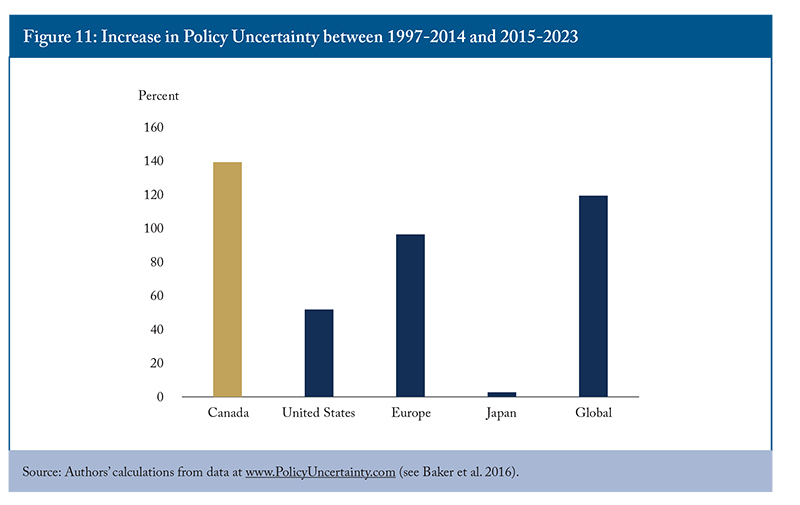
One possible influence is the increased distortion caused by varying marginal effective tax rates across different industries and types of capital. Bazel and Mintz (2021) calculate an index of inter-industry and inter-asset dispersion in marginal effective tax rates on investment in Canada, and find that it was more than 2.5 times higher in 2020 than in 2016. For example, investments in manufacturing faced an average marginal effective rate of 13.7 percent across the country – the rates were negative in the Atlantic provinces due to the Atlantic investment tax credit – while investments in communications faced an average marginal rate of 22.1 percent. When capital investments are influenced by these tax differences among regions, industries or assets, the overall productivity of the capital stock decreases.
Another factor might be the higher salience of personal income taxes as labour has become more mobile. The COVID pandemic led to more workers leaving traditional workplaces, working from home or other locations and potentially working from other countries. Although Canadian emigration data are incomplete and a methodology change in 2016 affected counts,14 quarterly data indicate more churn – larger flows of gross emigration and returning emigrants – since 2015.15 Remote work may have increased opportunities for higher-earning Canadians to work abroad.16 If these individuals took advantage of such opportunities, businesses would have less human capital, reducing their incentive to invest in physical capital.
Tax policy driven by populism might also blunt perceptions of opportunities in Canada. For instance, the misleadingly named “Canada Recovery Dividend” on large banks and insurers and a permanent corporate income tax rate increase on financial institution profits above $100 million owed little to economic logic and much to some voters’ irritation that financial institutions had fared relatively well during the pandemic (Kronick and Robson 2023). The 2021 luxury tax on certain cars, boats and airplanes is similar (Halpern-Shavin and Balkos 2023, Morneau and Reynolds 2023).
The federal government’s recent threats of tax measures to punish grocery retailers for high prices further illustrate populism overshadowing economic logic – how could higher taxes on retailers lower prices for consumers? The framing for the federal government’s recent increase in the inclusion rate for many types of capital gains was predominantly populist. Like policy uncertainty generally, perceptions of capricious tax policy reduce the dynamism that might otherwise spur consumer-friendly investments in the targeted sectors such as financial services or grocery retailing.
The list of likely negative influences on investment in Canada that may have become worse since 2014 is long, and the list of potential policy responses is almost as long. Some are easier to imagine addressing effectively in the short run than others.
The bias toward residential construction is a tough one to address. With the costs of owning and renting dwellings as high as it now is, it will be hard for governments to back away from housing activism and particularly hard for the federal government to reduce its support for mortgage lending. Slowing the rapid inflows of permanent and temporary immigrants that has exacerbated the pressure on housing markets would reduce the draw of residential investment on resources that would otherwise be available for non-residential capital investment and reduce any disincentive to non-residential capital investment created by abundant low-skilled labour (Doyle et al. 2024).
The hostile regulatory environment for Canada’s fossil fuel industry is easier to address. The case for Canada to lead the way to lower global greenhouse gas emissions by suppressing its own production of fossil fuels has never been convincing. Global energy demand will keep rising, fossil fuels supply most of the world’s energy and Canadian fossil fuels are economically, strategically and environmentally preferable to most others. The federal government should take a more investment-friendly approach to this sector.
The threat of US protectionism requires an aggressive courting of the United States and defence of Canada’s trade interests as pronounced as the efforts that preceded the 1988 Canada-US Free Trade Agreement and negotiated the evolution of the North American Free Trade Agreement into the Canada-US-Mexico Agreement. The right combination of trade concessions, complementary initiatives – notably increasing Canadian defence capabilities – and reminding US businesses, consumers and policymakers about the benefits of an integrated North American market can mitigate the potential thickening of the border in the eyes of investors.
Reducing the kinds of policy uncertainty that inhibit investment is largely about clarifying processes and criteria. Businesses crave stable rules and predictable outcomes. More systematic cost-benefit analyses both before and after legislation and regulations are established would help (OECD 2021). Less weaponizing of economic policy in the service of populist impulses would also improve the climate for business investment in Canada.
Turning to likely negative tax influences on investment – the gap between effective tax rates on small and larger businesses; lower effective tax rates on investment in the US post-2017; uneven tax rates on investment among regions, sectors and assets; and high personal tax rates – ambitious reformers might seek to address many of these negatives with a comprehensive overhaul of the tax system. Indeed, such an overhaul of the corporate tax system is arguably long overdue. Adopting an allowance for corporate equity (Milligan 2014, Boadway and Tremblay 2016), moving to a cash-flow tax base (McKenzie and Smart 2019) or taxing only distributed profits (Mintz 2022) could foster more investment and higher productivity.
Nearer term, however, reforms may need to be less ambitious. Consensus about the defects of Canada’s current system and ways to improve it seems far less than existed in the United States before its 2017 reforms.17 Major reforms are easier to accomplish when they are revenue-negative, and the fiscal positions of most senior governments in Canada will make them wary of forgoing revenue on the scale a major reform might require. In the current political climate, moreover, a push for a major overhaul might produce a tax system less supportive of investment and growth than the existing one.
The most promising near-term responses may be simple reductions in the most distorting tax rates – a lower general corporate income tax rate and lower personal rates at the top end. While politically challenging, such cuts are easy to legislate and there is evidence that the relevant tax bases are elastic enough to limit the impact of rate cuts on revenue.18 Lower top rates do not directly address all the defects in the tax system that blunt businesses’ responses to opportunities or make such opportunities less compelling in the first place, but they are uniquely far-reaching in reducing the distortions that lower investment and productivity.
Another near-term option that might jolt Canada out of a low-investment/low-productivity trap is a temporary general investment tax credit. Although more complicated to legislate and administer than a lower tax rate, a general investment tax credit (ITC) is a familiar tool with predictable effects. Ideally, a general ITC would replace the Atlantic investment tax credit and pre-empt other potential sector-specific ITCs such as the Clean Technology Manufacturing Investment Tax Credit. However, providing such a general credit at a meaningful rate – say 5 percent – would have major short-run revenue costs.
Applying a lower tax rate to business income derived from IP products would directly address Canada’s lagging performance in this sector. The frequently-applied label “patent boxes” is too narrow a conception: applying the lower rate to income attributable to IP products embedded in other goods and services would increase the incentive for IP products investment more broadly and would conform better with emerging international norms than a lower rate on income from patents alone. The federal government could offset any near-term revenue cost by reducing the subsidies it currently provides for research and development, which likely promote too much work of too low a quality to be commercialized (Lester 2022).
In addition to a change in the tone of tax policy – more focus on economic goals and less on political polls – the federal government particularly needs to change its fiscal stance. It needs to rein in normal program spending as well as subsidies delivered through the tax system, which are spending in disguise and drive up borrowing costs and interest payments. Since the last federal pre-COVID projections in the fall of 2019, successive fall economic statements have shown projected federal spending growing by leaps and bounds, even as COVID-related measures have wound down and dropped out of the projections.
The fiscal projections in the federal government’s 2019 fall statement ran up to the current fiscal year, predicting federal spending of $421 billion for 2024/25. However, the 2024 budget showed spending at $538 billion for this year – $117 billion (almost 30 percent) higher than the 2019 projections. This expansion of government, like excessive residential construction, absorbs resources that might otherwise be available for business investment. It also limits the scope for more ambitious tax reforms, which will probably require some short-term reduction in revenues.
Call to Action
The prospect that Canadians will find themselves increasingly relegated to lower value-added activities relative to US workers and elsewhere should spur Canadian policymakers to action. Current weakness in Canadian business investment compared to the past and compared to other countries is a threat to Canada’s prosperity and competitiveness. The fact that low productivity and investment have become higher-profile topics in Canada recently is an essential first step. To fix the problem, however, we need action: better tax and regulatory policies, and a reorientation of economic policy toward long-term growth.
References
Bafale, Mawakina, and William B.P. Robson. 2022. “Canadian Investment in Intellectual Property Products is Too Low.” Intelligence Memo. Toronto: C.D. Howe Institute. May.
Baker, Scott, Nicholas Bloom, and Steven J. Davis. 2016. “Measuring Economic Policy Uncertainty.” www.policyuncertainty.com/media/EPU_BBD_Mar2016.pdf.
Bazel, Philip, and Jack Mintz. 2021. “2020 Tax Competitiveness Report: Canada’s Investment Challenge” (2021) 14:21 SPP Research Papers, University of Calgary.
Boadway, Robin, and Jean-François Tremblay. 2016. Modernizing Business Taxation. Commentary 452. Toronto: C.D. Howe Institute, June.
Caselli, Francesco, and James Feyrer. 2007. “The Marginal Product of Capital.” The Quarterly Journal of Economics 122(2):535-568.
Casi, Elisa, Mohammed Mardan, and Barbara M.B. Stage. 2023. Citizenship/Residence by Investment and Digital Nomad Visas: The Golden Era of Individual Tax Evasion and Avoidance? NHH Department of Business and Management Science Discussion Paper no. 2023/12. Bergen: Norwegian School of Economics, Department of Business and Management Science. August.
Chen, D., and J.M. Mintz. 2015. “The 2014 Global Tax Competitiveness Report: A Proposed Business Tax Reform Agenda.” SPP Research Papers, University of Calgary, Vol. 8, Issue 4, February.
Chodorow-Reich, Gabriel, Matthew Smith, Owen Zidar, and Eric Zwick. 2023. “Tax Policy and Investment in a Global Economy.” Working Paper no. 2023-141 Chicago: University of Chicago, Becker Friedman Institute for Research in Economics, November.
Crawford, Steven, and Garen Markarian. 2024. “The Effects of the Tax Cuts and Jobs Act of 2017 on Corporate Investment.” Journal of Corporate Finance, Vol. 87, August.
Cross, Philip, and Jack Mintz. 2024. Canada’s Resource Sector: Protecting the Golden Goose. Ottawa: Macdonald Laurier Institute.
Dachis, Benjamin, and John Lester. 2015. Small Business Preferences as a Barrier to Growth: Not So Tall After All. Commentary 426. Toronto: C.D. Howe Institute.
Doyle, Matthew, Mikal Skuterud, and Christopher Worswick. 2024. Optimizing Immigration for Economic Growth. Commentary 662. Toronto: C.D. Howe Institute.
Ercolao, M. 2023. “Mind the Gap: Canada is Falling Behind the Standard-of-Living Curve.” TD Economics. July 13, 2023.
Grootendorst, Paul, Javad Moradpour, Michael Schunk, and Robert Van Exan. 2022. Home Remedies: How Should Canada Acquire Vaccines for the Next Pandemic? Commentary 622. Toronto: C.D. Howe Institute. May.
Gu, W. 2024. “Investment Slowdown in Canada After the Mid-2000s: The Role of Competition and Intangibles.” Analytical Studies Branch Research Paper Series. February 22, 2024.
Gu, W., and Willox, M. 2023. “The post-2001 productivity growth divergence between Canada and the United States: The role of the information and cultural services industry.” Economic and Social Reports. Ottawa: Statistics Canada.
Halpern-Shavim, Zvi, and Elena Balkos. 2023. “Evaluating Canada’s New Federal Luxury Tax.” Perspectives on Tax Law and Policy 4:1.
Kronick, Jeremy M., and William B.P. Robson. 2023. “Special Taxes on Large Canadian Banks and Life Insurers: How Necessary? How Evil?” Perspectives on Tax Law and Policy 4:1.
Laurin, Alexandre. 2018. “Unhappy Returns: A Preliminary Estimate of Taxpayer Responsiveness to the 2016 Top Tax Rate Hike.” E-Brief. Toronto: C.D. Howe Institute.
Lester, John. 2022. “Tax Support for R&D and Intellectual Property: Time for Some Bold Moves.” E-Brief. Toronto: C.D. Howe Institute, July.
__________. 2024. “Federal Business Subsidies: Explosive Growth Since 2014.” SPP Research Papers. 17 (1) University of Calgary.
Marion, S., and A. Ducharme. “2024. Canada is caught in a population trap.” National Bank of Canada. January 15, 2024.
Marple, James. 2021. “Meeting Canada’s Innovation Challenge through Targeted Investment and Competition.” TD Economics. July.
Mathur, Aparna, and Cody Kallen. 2017. “Business Tax Reform, Investment and GDP: Potential Impacts of the Tax Cuts and Jobs Act.” Daily Tax Report 1-7. American Enterprise Institute. December.
McCormack, Carter, and Weimin Wang. 2024. “Canada’s gross domestic product per capita: Perspectives on the return to trend.” Statistics Canada. April 24, 2024
McKenzie, Kenneth J., and Michael Smart. 2019. Tax Policy Next to the Elephant: Business Tax Reform in the Wake of the US Tax Cuts and Jobs Act. Commentary 537. Toronto: C.D. Howe Institute. March.
Milligan, Kevin. 2014. Tax Policy for a New Era: Promoting Economic Growth and Fairness. Benefactors Lecture 2014. Toronto: C.D. Howe Institute and Chartered Professional Accountants Canada.
Mintz, Jack M., and V. Balaji Venkatachalam. 2020. “Adjusting to Reality: As Proposed, Restricting Corporate Interest Deductibility Is Ill-Advised.” E-Brief. Toronto: C.D. Howe Institute. April.
Mintz, Jack. 2022. “A Proposal for a ‘Big Bang’ Corporate Tax Reform.” SPP Research Papers. University of Calgary.
Morneau, Bill, and John Lawrence Reynolds. 2023. Where to from Here? A Path to Canadian Prosperity. Toronto: ECW Press.
Omran, Farah, and Jeremy Kronick. 2019. “The Productivity Opportunity in Canada’s Financial Sector.” Intelligence Memo. Toronto: C.D. Howe Institute November 21.
Organisation for Economic Co-operation and Development. 2009. Measuring Capital - OECD Manual 2009: Second edition, OECD Publishing, Paris, https://doi.org/10.1787/9789264068476-en.
_________. 2024. OECD Product Market Regulation (PMR) indicators: How does Canada compare? https://www.oecd.org/content/dam/oecd/en/topics/policy-sub-issues/produ…
Parliamentary Budget Office. 2023. “Break-even Analysis of Production Subsidies for Stellantis-LGES and Volkswagen.” Ottawa: September. Retrieved from: https://www.pbo-dpb.ca/en/publications/RP-2324-015-S--break-even-analys….
Porter, Douglas. 2023. “Canada’s Perennial Productivity Puzzle,” Focus: A Weekly Financial Digest. Bank of Montreal. November 3.
_____________. 2024. “Canadian Growth: Time for a Rethink.” BMO Economics. March 8.
Rao, Someshwar, Jianmin Tang, and Weimin Wang. 2003. “Canada’s Recent Productivity Record and Capital Accumulation.” Industry Canada.
Raymunt, Monica. 2023. “VW lays off workers at key EV factory over cratering demand.” The Financial Post. September 14.
Robson, William B.P., and Mawakina Bafale. 2022. Decapitalization: Weak Business Investment Threatens Canadian Prosperity. Commentary 625. Toronto: C.D. Howe Institute. August.
Robson, William. 2024. “Weak Canadian Investment and Productivity: How Tax Policy Can Help.” Canadian Tax Journal.
Robson, William B.P., Don Drummond, and Alexandre Laurin. 2023. The Morning After: A Post-Binge Federal Shadow Budget for 2023. Commentary 638. Toronto: C.D. Howe Institute. February.
Rogers, Carolyn. 2024. “Time to break the glass: Fixing Canada’s productivity problem.” Speech to the Halifax Partnership. Halifax, Nova Scotia, March 26.
Sala-i-Martin, Xavier. 1997. “I Just Ran Four Million Regressions.” National Bureau of Economic Research. Working Paper No. 6252.
__________________. 2001. “15 Years of New Growth Economics: What Have We Learnt?” Speech, Fifth Annual Conference of the Central Bank of Chile. November.
Schwanen, Daniel. 2018. “NAFTA: The Case for More Competition in the Dairy Market.” Intelligence Memo. Toronto: C.D. Howe Institute. September.
Singh, Kartikeya, and Aparna Mathur. 2019. “The Impact of GILTI and FDII on the Investment Location Choice of U.S. Multinationals,” Columbia Journal of Tax Law Vol. 10, No. 2, September.
Skuterud, Mikal. 2023. “Canada’s Missing Workers: Temporary Residents Working in Canada.” E-Brief. Toronto: C.D. Howe Institute. September.
Statistics Canada. 2016. “User Guide: Canadian System of Macroeconomic Accounts. Chapter 5 Income and expenditure accounts.” Catalog No. 13-606-G. August.
_____________. 2018. “Canadian System of Macroeconomic Accounts, Investment and Capital Stock Statistics.” Retrieved from: https://www150.statcan.gc.ca/n1/pub/13- 607-x/2016001/43-eng.htm.
Stewart, Luke A., and Robert D. Atkinson. 2013. “Restoring America’s Lagging Investment in Capital Goods.” The Information Technology & Innovation Foundation. October.
Trebilcock, Michael. 2017. “Ontario’s Green Energy Experience: Sobering Lessons for Sustainable Climate Change Policies.” E-Brief. Toronto: C.D. Howe Institute.
Wen, Jean-Francois, and Fatih Yilmaz. 2020. Tax Elasticity Estimates for Capital Stocks in Canada, IMF Working Paper no. WP/20/77. Washington, DC: International Monetary Fund.
- 1 The idea that capital accumulation drives economic growth goes back centuries. Solow (1956) developed a key formal model of the process that shows how a rising stock of capital expands output and output per worker. Driven in part by the recognition that models like Solow’s predict similar productivity growth across countries and constant saving rates, when growth and saving rates actually differ across countries over long periods of time, other models have explored possible reinforcing effects of investment on multifactor productivity and vice versa. Sala-i-Martin (1997) and Caselli and Feyrer (2007) provide key investigations of the correlation between growth and investment at the national level. Recent work at Statistics Canada (Gu 2024) highlights the importance of investment for Canadian productivity growth and living standards.
- 2 OECD labour-force data are based on national labour-force surveys. Canada’s Labour Force Survey counts people aged 15 and older. Most developed countries, including the United States and in Europe, count people aged 16 and over. Fifteen-year-olds are below school-leaving age, and their labour-force participation rate is low – below 30 percent in 2023 – and they make up less than 1 percent of Canada’s labour-force, so this difference affects comparisons of capital and investment per available worker little, and affects trends over time less.
- 3 The capital stock measures from the OECD and Statistics Canada are not identical because the OECD uses an age-efficiency calculation to estimate the lower productive capacity of older assets (OECD 2009), while Statistics Canada uses a more traditional depreciation formula. We use the OECD measures for every country when making international comparisons. We stress the amount of capital stock per member of the labour force to highlight the links among capital, productivity and incomes at the individual worker level. Capital per potential worker is a more attractive measure for comparisons over time and across countries than capital per person of labour-force age or capital per employed person because labour-force participation, like business investment, varies with the economic cycle but less so than employment. We use the total labour force because capital invested by business generates the incomes that support both private-sector and public-sector workers and because total labour-force figures are likelier to be comparable across jurisdictions that classify private- and public-sector workers differently.
- 4 Canada has welcomed many temporary residents in recent years, but there is some discrepancy between the number of temporary residents in the Labour Force Survey (LFS) and the number of temporary foreign workers reported by Immigration, Refugees and Citizenship Canada (IRCC). Skuterud (2023) shows that the number of temporary foreign workers recorded by IRCC was 1.1 million higher than that of the LFS in 2022. To account for this, we have increased the labour force figures for the first quarter of 2022 by a ratio constructed from the populations in Statistics Canada tables 17-10-0009-01 and 14-10-0287-01. Our adjustment adds 163,000 available workers in the first quarter of 2024 than indicated by the LFS, and adds 100,000 more workers on average since the first quarter of 2022.
- 5 Investment goods and services tend to be less expensive in the United States than in Canada. For that reason, using the market exchange rate to convert US capital expenditures to Canadian dollars would understate the relative bang US companies get per investment buck. Statistics Canada used the triennial benchmark estimates from the OECD to extrapolate purchasing power of investment spending between Canada and the United States. (Data are available in its Table 36-10-0367-01.)
- 6 Our measure of business investment per available worker for the OECD is the ratio of aggregate business investment – the sum of business investment in each OECD country in Canadian dollars adjusted for purchasing power – to the aggregate labour force. The measures for other OECD countries are the aggregate measures minus Canada and the United States.
- 7 We use the OECD purchasing power data, the most recent being for 2022, when the purchasing power of a US dollar with respect to investment goods and services was C$1.17 – that is, US$100 of investment goods and services would cost US$117 in Canada.
- 8 Lester (2024) concludes that about 80 percent of federal business subsidies harm rather than help Canada’s economic performance. Among currently relevant examples of actual or potential investments that lower living standards are support for intermittent electricity generation that lacks suitable storage or transmission (Trebilcock 2017), dairy farms that require prohibitive tariffs to survive (Schwanen 2018), an inefficient new public agency to pursue vaccine self-sufficiency (Grootendorst et al. 2022) or subsidizing the manufacture of batteries for electric vehicles that may not sell (Raymunt 2023, Parliamentary Budget Office 2023).
- 9 This section draws heavily on Robson (2024).
- 10 The share of residential construction in gross fixed capital formation was 38 percent in 2015 and 2023, while that of non-residential construction fell from 33 percent in 2015 to 30 percent in 2023 (Statistics Canada Table 36-10-0108-01).
- 11 Cross and Mintz (2024) document the combined impacy of tax and tegulatory delays on natural resource projects in Canada, and note that, since the passage of the federal Impact Assessment Act in 2019, only one natural resource project has been approved under the new regime.
- 12 Over the two decades to the fourth quarter of 2014, Canada’s population growth rate averaged 1 percent annually. It rose to 1.5 percent by the beginning of 2020 and, after a COVID-induced dip in 2020-2021, rose to more than 3.2 percent by early 2024 (Statistics Canada Table 17-10-0009-01).
- 13 The index is constructed using the prevalence of terms associated with economic uncertainty as used in Canadian newspapers. For example, “uncertainty,” “economy,” “policy” and “regulation” are identified in each newspaper. The monthly series specific to each newspaper are then standardized and added together. The resulting series is normalized to mean 100 before 2011.
- 14 Until June 2016, Statistics Canada included an estimate of net temporary emigration in its net emigration numbers. Since then, it has reported gross emigration and returning emigrants. See Statistics Canada table 17-10-0040-01 (formerly CANSIM table 051-0037), “Estimates of the Components of International Migration, Quarterly.”
- 15 Gross emigration has recently been running at an annual rate of 0.24 percent of the population, up from 0.19 percent before 2015. Emigrants recently have been returning at an annual rate of 0.15 percent of the population, up from 0.10 percent before 2015. (Calculated from Statistics Canada table 17-10-0040-01, supra note 29; and Statistics Canada table 17-10-0009-01 [formerly CANSIM table 051-0005], “Population Estimates, Quarterly.”)
- 16 Remote work increases opportunities to take advantage of special tax, residency or citizenship provisions that countries use to attract people with financial wealth, high incomes and special skills. Casi, Mardan and Stage (2023) document the post-pandemic spread of “digital nomad” visas, notably in countries traditionally considered to be tax havens.
- 17 Some impending tax changes, notably proposed new limits on the deductibility of interest and financing expenses, would increase marginal tax rates on investment (Mintz and Venkatachalam 2020) and exacerbate the distortions favouring shorter-lived over longer-lived assets (Bazel and Mintz 2021).
- 18 Robson et al. (2023) estimate that a two-percentage-point cut in the general corporate income tax rate would have a static revenue cost of about $5 billion. Laurin (2018) estimates that the revenue yield of the federal government’s 2016 increase in the top personal tax rate was only about one-third of what it would have been without behavioural responses, not including one-time shifts in recognition of income.







